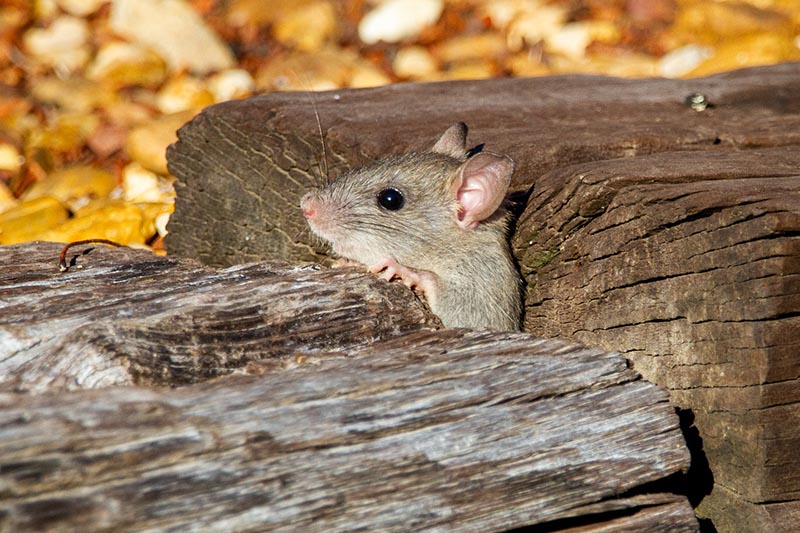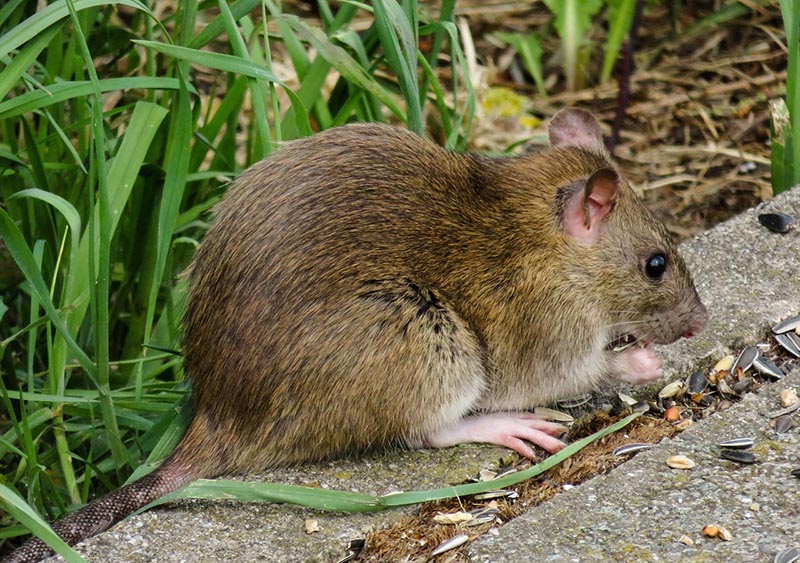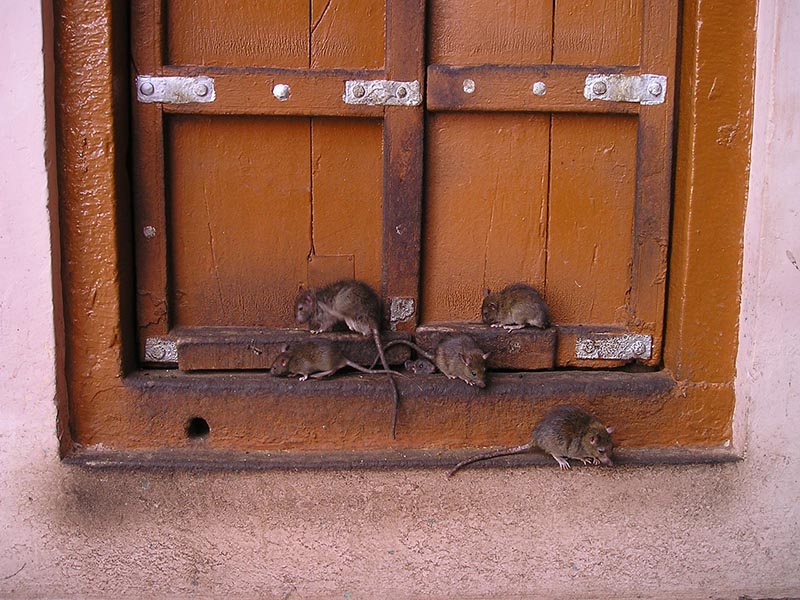Rats in South Carolina: Types, Facts & Tips for Homeowners
-
Pete Ortiz
- Last updated:

While we’re busy swatting mosquitoes and dealing with Palmetto bug invasions in South Carolina, it’s easy to forget some of the more dangerous pests lurking in our backyards.
Rats don’t get much regard unless you’re dealing with an infestation, but they’re surprisingly abundant throughout the state. Greenville is even a perennial feature among the most rat-infested cities in the country.
Given their ability to cause severe property damage and spread disease, being aware of rat activity in your neighborhood will be crucial in protecting your family and home. We’ll discuss the most common types of rats in South Carolina and offer tips for homeowners to help keep these rodents at bay.
The 4 Types of Rat in South Carolina
1. Norway Rat (Brown Rat)

| Scientific Name: | Rattus norvegicus |
| Length: | 9” body; 17” w/ tail |
| Color: | Brown/light brown |
The Norway rat is the longest, plumpest, and most common rat in South Carolina. Originating in China, these rats arrived in the states in the 1700s from Europe and now appear throughout North America. You can find them on every continent on the globe except Antarctica. Several types of Norway rats in brown and white varieties are bred as domesticated pets, while select outbred albino varieties are often preferred subjects in scientific studies.
In South Carolina, Norway rats dig burrows and tunnels in varied settings, including farms, wharves, fields, sewers, junk piles, and riverbanks. The opportunistic feeders enjoy urban areas, often building 3-foot-long burrows under gardens, sidewalks, foundations, and any place providing food, shelter, and a nearby water source. They typically operate within a 100–150-foot territory but will extend it up to 300 feet.
Norway rats live indoors when possible, typically inhabiting basements and lower floors due to their poor agility. As a colony grows, it can spread through a home. Nests often consist of shredded paper, cloth, cardboard, and other workable materials.
Norway Rat Breeding and Feeding Habits
Norway rats develop a hierarchical system in colonies led by the largest male rat. Females breed throughout the year and produce around seven litters annually, each consisting of 7–11 pups. Nests consist of roughly 5–12 rats, with migrations occurring when they become overly populated.
Given their poor eyesight and enhanced hearing, Norway rats are nocturnal. Their undemanding diet consists mostly of whatever is available. They prefer fresh offerings provided by a household, particularly cereal grains, nuts, pet food, and high-protein foods. In a pinch, they’ll settle on fruits, veggies, garbage, compost, and animal feces. They’ll even feed on other small animals, including poultry, birds, fish, and other rodents.
Identifying Norway Rats
Mature Norway rats have heavy bodies that can grow up to 9 inches long. Their scaly, hairless tails are shorter than their bodies, adding another 6–8 inches in length. Fur is brown with specks of black, and the underside is usually a lighter grayish-brown. Other distinguishing features include small bulging eyes, blunt noses, and rounded ears.
You’ll find evidence of Norway rats in scat, gnaw marks, and trails. Capsule-shaped droppings are ½–¾ inch in length, often appearing near food sources, behind appliances, along walls, and on lower levels of the home in general.
Greasy trails can pop up along frequented paths, and you may notice gnaw marks in food containers, door bottoms, drywall, and wood framing. Their teeth grow constantly, and Norway rats will chew on nearly any building material to wear them down.
2. Black Rat (Roof Rat)

| Scientific name: | Rattus rattus |
| Length: | 8” body; 16” w/ tail |
| Color: | Dark brown/black |
Although it also prefers to live around people, the black rat is easily distinguishable from the Norway rat in looks and habits. They have thinner, nimbler bodies than Norway rats, allowing them to squeeze through tight spaces and climb efficiently. While their larger brown counterparts will enter a building at ground level, black rats prefer to invade homes via the roof.
Black rats are less common than Norway rats in South Carolina and the U.S. They primarily live in coastal and southern states, where you can find them in barns, fields, attics, wall voids, and roof rafters in warehouses. In the wild, they’ll live in trees such as pines and palms, though they will dig out burrows or nest in cliffs and rocks, depending on what’s available.
With greater size, aggression, and adaptability to urban settings, Norway rats often force black rats out of their territory. Norway rats are also stronger swimmers, making them more likely to live around riverbanks and marshes.
Black Rat Breeding and Feeding Habits
Black rats live in male-dominated nests, similar to Norway rats. Mature females produce 4–6 litters a year, with each containing up to eight pups. As with Norway rats, infants are weaned within about 3 weeks and develop into mature adults in about 3–4 months. Black rats have a shorter lifespan than Norway rats, often living only one year.
Black rats are also nocturnal, coming out at sunset to forage for food. They primarily target fruits, particularly citrus and avocados, as well as seeds, nuts, and cereal grains. Like Norway rats, omnivorous black rats have preferences but will eat nearly anything. Outside, they’ll opt for insects, birds, reptiles, and other small animals if needed.
Identifying Black Rats
The black rat is slightly smaller and slimmer than a Norway rat, typically growing up to 16 inches long with a hairless tail longer than its body. Its fur is dark brown or black, while the underside is a lighter gray. Compared to Norway rats, black rats have bigger eyes and ears and more pointed noses.
Black rats leave signs of activity similar to Norway rats, but droppings and the location of gnaw marks, nests, and grease trails can indicate which type is in the house. Droppings are smaller than those of Norway rats and have sharper points. Meanwhile, if you find signs of damage and nesting in the attic or hear skittering and squeaking overhead, you likely have a black rat.
3. Eastern Woodrat (Pack Rat)

| Scientific Name: | Neotoma floridana |
| Length: | 8” body; 17” w/ tail |
| Color: | Grayish brown |
Eastern woodrats do not prefer the company of people; instead they opt to live in deciduous forests, swamps, and lowland forests. In South Carolina, these rodents primarily live along the coast and in the lower Piedmont region.
While they may occasionally inhabit an abandoned structure, eastern woodrats will build nests in rocky mountainsides, hollow tree trunks, brush piles, and other sheltered areas, constructing them out of whatever is available, from sticks and twigs to dried feces and trash. A unique habit of woodrats is to steal shiny objects, like keys and bottle caps, to line their nests, earning them the nickname “pack rats.”
Only one woodrat inhabits a nest at a time. The dens (or middens) can grow quite large, as future generations of woodrats may inhabit old nests and continue building onto them.
Eastern Woodrat Breeding and Feeding Habits
Eastern woodrats are solitary, aggressive towards others, and not as prolific as commensal black and Norway rats. They may breed year-round but usually stay at their most active from February to August. Females produce 2–3 litters in a year, each only having 1–6 newborns. Infants are weaned in about 3–4 months but can take 6–8 months to reach their mature size.
The eastern woodrat diet consists primarily of plants. The nocturnal creatures will come out of hiding at night to eat leaves, plant stems and bark, fruits, berries, fungi, ferns, seeds, and nuts.
Identifying Eastern Woodrats
Eastern woodrats are slightly smaller than Norway and black rats and sport long, hair-covered tails. They can grow up to 16 inches long. The fur is a grayish-brown color that gets darker toward the back, lightens on the sides, and becomes white on the woodrat’s underside. Their eyes are black and bulging, and their ears are large and rounded.
4. Allegheny Woodrat
| Scientific Name: | Neotoma magister |
| Length: | 8” body; 17” w/ tail |
| Color: | Grayish brown |
The Allegheny woodrat is challenging to differentiate from the eastern woodrat. The two were even considered the same species until the early 2000s. They build similar nests, have the same mating and eating habits, and look virtually identical.
The primary difference is that the Allegheny woodrat isn’t as widespread. They’re mostly limited to the mountainous northwest corner of South Carolina, where they nest and forage in deciduous forests.
The Danger of Rat Infestations
The most hazardous types of rats in South Carolina are Norway and black rats, as both are eager to take up residence in occupied homes where they can wreak havoc. One of the primary concerns is the long list of dangerous diseases they can bring into the house, including:
- Bubonic plague
- Typhoid
- Dysentery
- Leptospirosis
- Salmonellosis
- Spotted fever
- Toxoplasmosis
Rats can spread disease directly through droppings, urine, and food invasion. More often, pathogens enter the home via vectors attached to the rat, such as ticks, mites, and fleas.
Aside from disease, property damage is an essential concern. Rats are notorious agricultural headaches, and their voracious eating habits can spell disaster for a garden. But for the average homeowner, household damage is the greater issue by far.
Like most rodents, Norway and black rats have to gnaw to keep their teeth from growing too large. And they’ll gnaw on just about anything, whether it’s wood, metal, or plastic. That can include doors, wood framing, pipes, water lines, and floors. According to some estimates, rodents gnawing on electrical wiring causes up to 25% of unexplained house fires.

When Is Peak Rodent Season?
Rats in South Carolina are active year-round, and the warm weather allows them to extend their breeding season. While you can see signs of an infestation at any time, they are more likely to seek shelter inside when the temperature falls in winter.
How to Prevent Rats
In truth, preventing rats begins and ends with preventing another common South Carolina pest, the house mouse. Of any rodent in the state, house mice are the most likely to invade a home, and if you can keep them out, you can keep out a rat. House mice can squeeze through holes as small as ¼ of an inch and are as agile as black rats, capable of using the same entrances that rats use and more.
Follow these tips to reduce your chances of mouse or rat infestations:
- Install door sweeps and weather-stripping to exterior doors
- Add metal screens to chimneys and exterior ports
- Clean up food spills and buildup in the sink
- Remove old boxes, piles of clothes, and other clutter and maintain a tidy home
- Seal cracks, gaps, and holes with caulk or concrete
- Keep food in airtight containers
- Make pet food and water dishes inaccessible
- Trim back bushes and other vegetation at least two feet from the home’s foundation
- Maintain a dry, well-ventilated attic and basement
- Keep lumber, firewood, and piles that could create potential hiding spots at least 20 feet away from the house
- Seal all garbage and recycling bins and take the trash out every night
- Remove bird feeders and bird baths from the lawn
- Trim back overhanging trees
- Fix plumbing leaks, slow-running drains, and anything that may provide a water source
- Remove fallen fruit nuts and other debris from your yard

If rats have been an issue in your home before, monitoring for activity is crucial. Keep an eye out for burrows around your foundation, damaged garden plants, and other signs of life.
Don’t hesitate to call an exterminator when you hear or find signs of a rat in the home. You can try rat traps and poisons for new infestations, but don’t wait too long to call in the pros. Rats reproduce quickly and cause damage faster than mice, so there’s no time for ineffective methods.
If rat droppings, chew marks, and the sound of movement continue, it’s time to call an exterminator. And no matter what you have tried before, drop everything and call an expert when you see one before you, especially during the daytime.
Rats will only step outside their comfort zone when necessary, and needs intensify as the colony expands. You may be lucky and only have one, but generally, for every rat you see, there are likely several more that you don’t see.
In Conclusion
Norway and black rats are the most likely rats in South Carolina to cause issues. They can be remarkably destructive, spreading disease and damaging property in a short time. Identifying and protecting your home against these voracious pests can make the difference between dealing with a minor inconvenience and a life-changing catastrophe.
Featured Image Credit: Joshua J. Cotten, Unsplash
Contents




